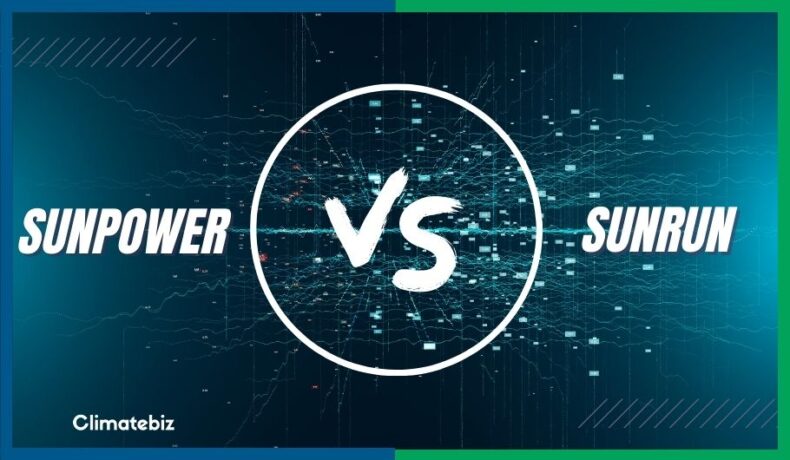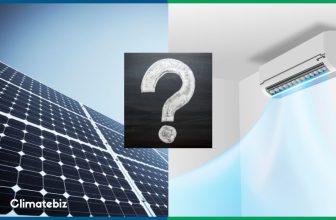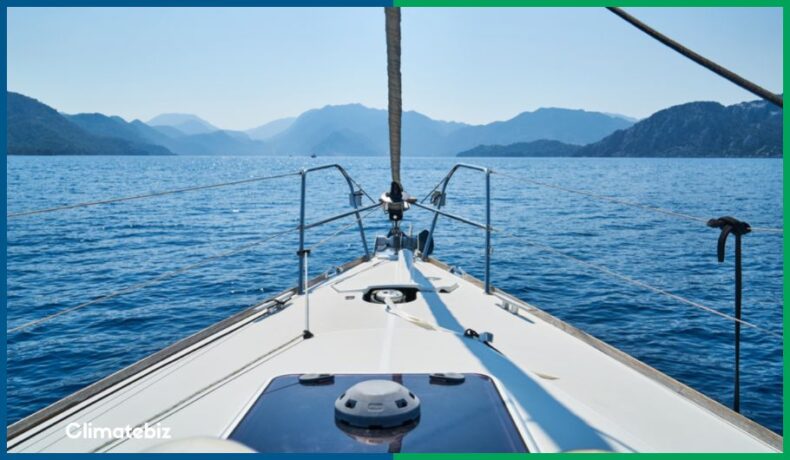
Are you struggling with the number of solar panels you need to install on your boat? We’ll help you find the answer!
Installing solar panels on your boat is the best way to generate clean and free energy to charge your boat’s batteries and keep your appliances running.
Solar panels aren’t noisy like wind generators. They don’t release harmful gases like gas-powered generators and don’t damage your batteries over time, which can happen when you use your engine’s alternator to charge your house batteries.
Instead, they harness energy from the sun to create DC electricity, which is stored in your batteries and used to power your boat’s appliances.
However, all of these perks come at a relatively high cost.
So to avoid spending extra money on a solar setup too big for your needs (and also for your boat), a good starting point is to estimate how many solar panels you need in your boat.
In this article, we help you figure out how many solar panels you need for your boat. We also discuss the types of solar panels and which is best for boats.
Finally, we show you the average prices for marine solar panels.
Affiliate Disclaimer
Table of Contents
How Many Solar Panels Do I Need For A Boat?
If you think that sizing a solar array for your boat follows the same process as it would for your home, you’d be wrong.
This is because land-based solar panels are fixed. Moreover, you can angle them toward the sun to increase overall performance.
It’s easy to understand why you can’t do this with solar panels on boats.
When cruising on your boat, the solar arrays continuously move relative to the sun, so achieving an optimal solar gain orientation/angle is almost impossible.
For this reason (and a few others, like wind, partial shadow, etc.), land-based solar calculations don’t apply well to boats.
But don’t worry; we show you an easy way to estimate how many solar panels you need for your boat.
Sizing A Solar Array For Your Boat
For the estimation, you first have to answer a few questions, such as:
- Do you want to rely solely on solar power, or will you still use your alternator or generator to charge your house batteries partially?
- If you’re only using solar energy, what’s your estimated daily electricity usage?
- How much room do you have on your boat (to install the panels)?
- How many peak sun hours will you get daily (based on location)?
- For how long will you run each appliance/device?
Once you have the answers to these questions, you can start calculating the number of solar panels you need to install on your boat.
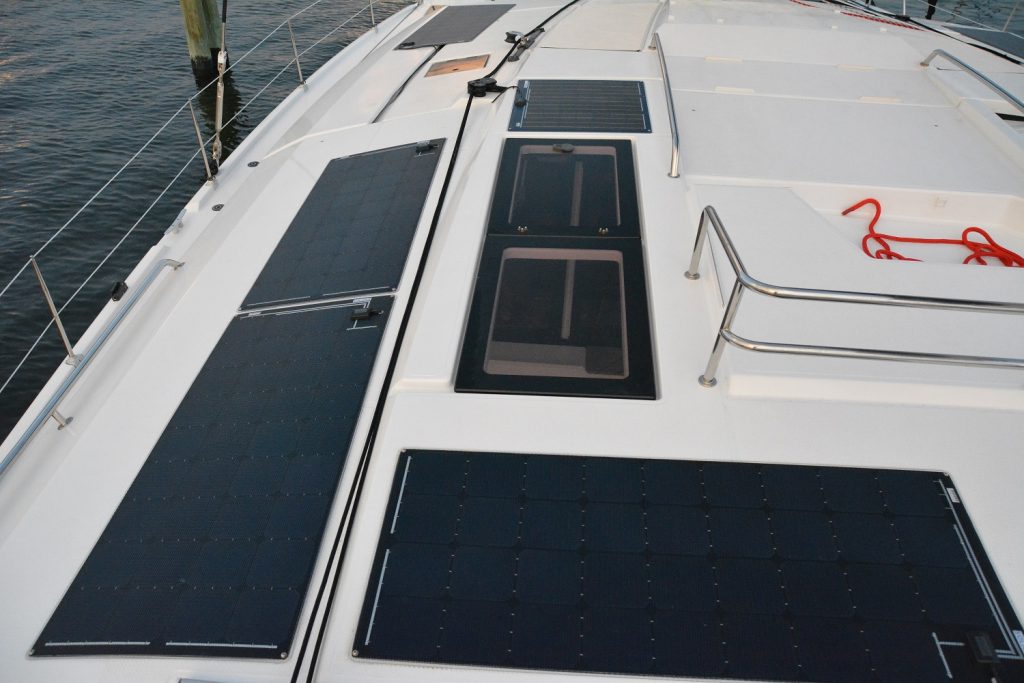
Source: oceanplanetenergy.com
How To Calculate The Number Of Solar Panels For A Boat
1. If You Want To Rely Solely On Solar Power
If you wish to power all your boat devices and appliances solely with solar power, then here’s how to calculate the number of solar panels you’ll need to install on your boat.
First and foremost, you need to determine your average daily electricity usage.
You can either express your daily usage in watts per hour (Wh) or amp-hours (Ah). The latter is easier when it comes to boats because most boat devices and appliances run on DC electricity, so you need your panel to produce the same amount of Ah that you consume daily.
Most appliances have ampere ratings written on them, usually at the back. Conversely, if you only find the wattage, divide it by the rated voltage of the device since:
Amperage (A) = Wattage (W) / Voltage (V)
Step 1: Make A List Of Your Appliances
Make a list with the amperage of each appliance and the number of hours per day you plan to use each. Here’s an example:
| Appliance | Amperage (A) | Hours of use (daily) | Ah per day (A x h) |
|---|---|---|---|
| Mini Fridge | 5 A | 8 h | 40 Ah |
| Fresh Water Pump | 9 A | 1 h | 9 Ah |
| Small TV | 6 A | 2 h | 12 Ah |
| Stereo | 1.5 A | 2 h | 3 Ah |
| Phone Charger | 0.5 A | 2 h | 1 Ah |
| VHF Radio | 0.6 A | 8 h | 4.8 Ah |
| Three LED lights | 0.7 A (each), 2.1 A total | 4 h | 8.4 Ah |
| Chartplotter / GPS | 0.85 A | 8 h | 6.8 Ah |
| Broadband Radar | 1 A | 4 h | 4 Ah |
Then, calculate the total sum of Ah consumed per day. For our example (table above), the total is 89 Ah.
Add an extra 15% to your daily consumption to account for inefficiencies. So, 89 Ah x 1.15 = 102.35 Ah (let’s consider 102 Ah).
Step 2: Divide The Total Ah By The Number Of Sun Hours
Once you’ve calculated the amount of Ah you consume daily, divide this number by the average daily peak sun hours (according to your location).
Because you can’t strictly aim your panels toward the sun, let’s assume about 4 hours of total rated current output per day, on average, for the Northern climates. (For places closer to Ecuador, you can consider 5 hours of peak sun hours/day.)
This way:
Ah Required Daily / Average Peak Sun hours = 102 Ah / 4 h = 25.5 A
Therefore, your solar array should be big enough to provide 25.5 A per hour of sun.
Now, divide this number by the operating current of your chosen solar panel.
For instance, if you choose to use 200 W monocrystalline solar panels (operating current is usually 8.5 A for an 18 V module), then you’ll need to install 3 solar panels:
Amps required per peak sun hour (A) / Panel’s Operating Current (A) = 25.5 A / 8.5 A = 3 panels
Simply follow these calculation steps to estimate how many solar panels you need for your boat.
What if you don’t have enough space in your boat to add that many panels? In this case, consider adding modules with higher power output. You might be able to produce the same amount of energy while using less space.
Alternatively, study the possibility of using a pole mount to install your solar panels.
2. If You’ll Use Solar Just to Partially Charge Your House Batteries
Adding solar panels is still a wise choice even if you have other energy sources on your boat — like your alternator or a standard generator.
The obvious reason is that solar energy is clean and renewable, is not loud and harmful like a generator, and doesn’t potentially decrease your battery’s lifespan (which can happen when charging batteries with an alternator).
In this case, you can size your solar array according to the size of your battery bank.
Examples
Let’s say you have a 200 Ah battery bank, and you use your alternator to charge 75% of your bank’s capacity and your solar panels for the last 25% of capacity (so from 75% to 100% state of charge).
In this case, you’d need your solar panel system to produce 57.5 Ah per day to charge your battery bank fully. To be safe, add an extra 15% to account for inefficiencies. This way, you’ll need to produce approximately 66 Ah (57.5 Ah x 1.15 = 66.125 Ah).
Now, you need to find out how many panels you need to install to produce this amount of amps daily. This depends on the wattage of the panel you want to use.
For A 100W Flexible Panel
The open circuit voltage of an 18V, 100W flexible monocrystalline solar panel, is usually 22.5V. Therefore, its operating current is:
Operating Current (A) = Wattage (W) / Voltage (V) = 100W / 22.5 V = 4.44 A
Therefore, in a day (considering 4 peak sun hours), a single 100W flexible mono panel will produce:
Operating current of a 100W panel x peak sun hours = 4.44 A x 4 h = 17.76 Ah (let’s consider 17 Ah)
So, to produce 66 Ah a day, you’d need:
Total Amps you need / amps a 100W produces in a day = 66 Ah / 17 Ah = 3.88 (4 panels)
You’d need four 100W flexible monocrystalline solar panels for this.
Please note: to safely use an 18V solar panel to charge a 12V battery bank, you must add a charge controller to your solar setup. Otherwise, your battery bank can overcharge, causing damage or shortening your battery’s lifespan.
For A 200W Rigid Monocrystalline Solar Panel
We can simply repeat the previous calculations, replacing the wattage and voltage specifications.
Considering the open circuit voltage as 22.5 V, let’s calculate the panel’s operating current:
Operating Current (A) = Wattage (W) / Voltage (V) = 200W / 22.5 V = 8.88 A
Therefore, in a day (considering 4 peak sun hours), a single 200W rigid mono panel will produce:
Operating current of a 200W panel x peak sun hours = 8.88 A x 4 h = 35.52 Ah (let’s consider 35 Ah)
So, to produce 66 Ah a day, you’d need:
Total Amps you need / amps a 200W produces in a day = 66 Ah / 35 Ah = 1.88 (2 panels)
In this case, you’d need two 200W solar panels or four 100W flexible monocrystalline solar panels for this.
As expected, if you double the wattage of the panel you’re using, you’ll need half of the number of panels.
Are Boat Solar Panels Different From Home Panels?
Yes, there are different solar panels; depending on the case, one might be preferable over the others.
Basically, boat solar panels should be able to withstand the harsh marine environment, which can be tough on equipment — especially salt water.
Therefore, boat solar panels should be well-sealed and waterproof (IP65, IP67, or IP68), and the electronic components on the back of the panel should be encased in an inert non-corrosive waterproof material (like silicone).
In addition, marine-grade solar panels are usually built with bypass diodes to reduce the impact of shading on a boat.
Another factor to consider is the uneven surfaces you find on different boats. Marine solar panels are usually made of more flexible materials to make the installation easier on various surfaces (rigid, curved deck, bimini top, etc.).
Moreover, the flexible/curved kind can sometimes help optimize performance once it can offset the angle variations between the sun and the panel when the boat is moving.
Are Flexible Solar Panels More Recommended For Boats?
In terms of rigidity, there are three main types of panels:
- Rigid Solar Panels (home solar panels)
- Semi-Rigid Solar Panels (also called “walk-on” panels)
- Semi-Flexible
In most cases, the semi-flexible solar panel is the preferred type for marine applications. However, this might not be the case for you.
For instance, if you have a large boat with enough space to install more robust solar panels, the semi-flexible panels may not be your best option.
So make sure to do your research before making your final decision.
And to help you with that, we’ll discuss each type of panel individually.
Rigid Solar Panels
Typically, the standard home solar panels follow the same design: a rigid metal frame that holds together several different layers of material, including solar cells and tempered glass.
They’re usually 1.2 to 1.5 inches thick (approximately 30 to 40 mm), and you’ll probably need to drill holes in the boat’s surface to mount these panels properly. This is one of the downsides of the rigid type panel.
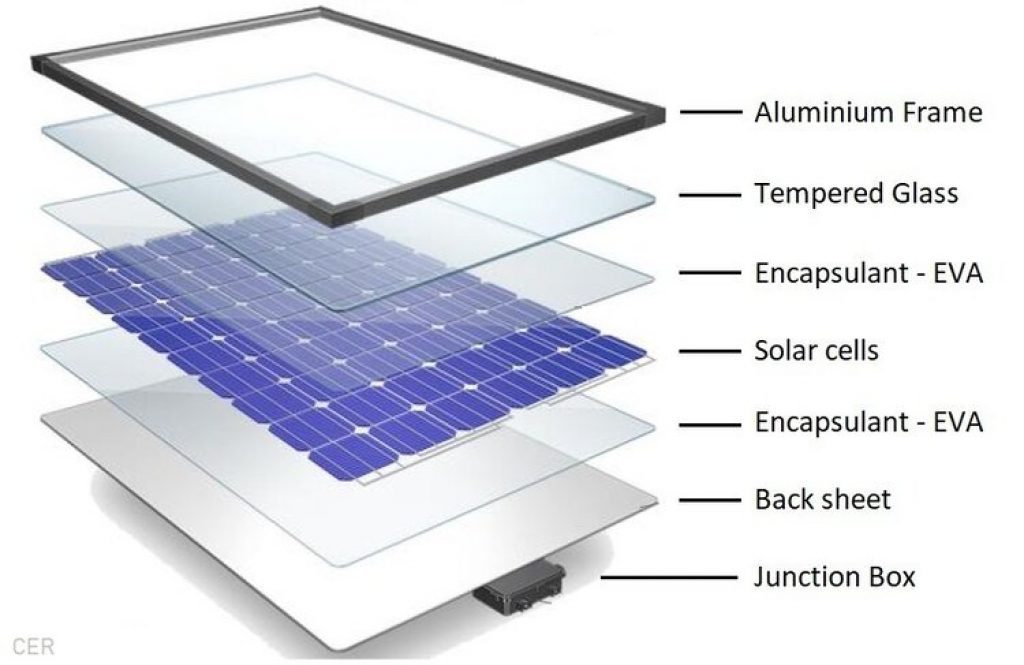
Source: cleanenergyreviews.info
This type of panel is often large and heavy, so it’s not the best option for small boats.
It is ideal for mounting on a rigid boat surface or top-of-pole mounting.

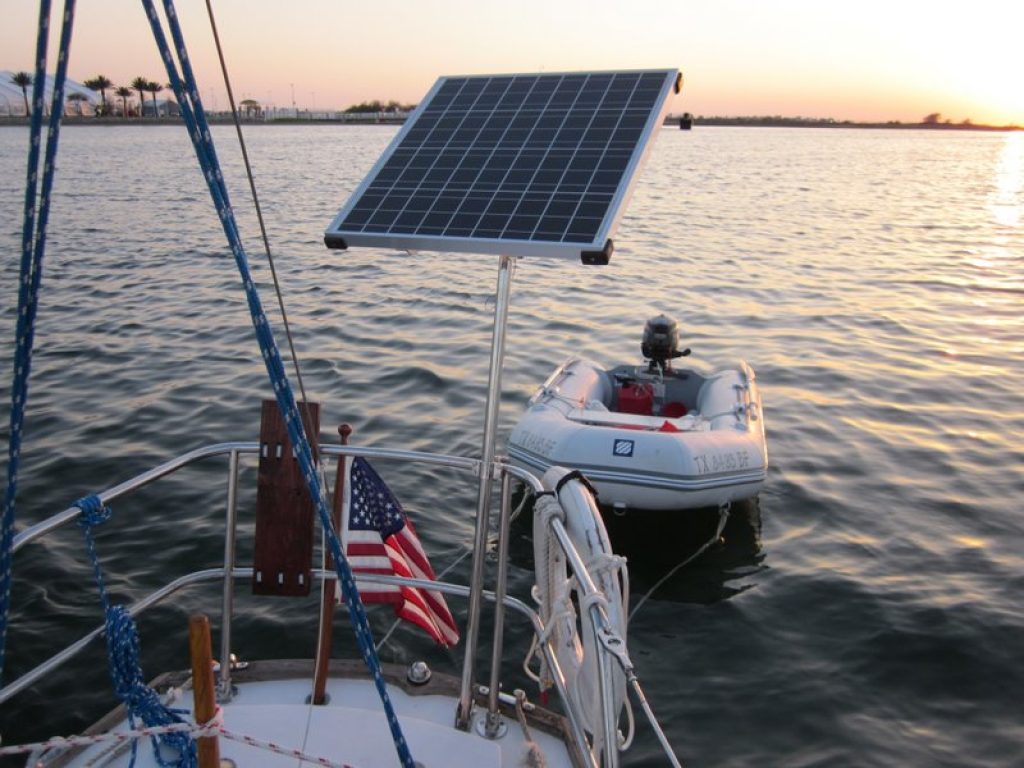
The rigid solar panels must be waterproof for marine applications and have anticorrosion frames, marine-grade sealants, and a water protection junction box.
Rigid panels are robust and efficient; if adequately cared for, they can last many years.
So if you have the space in your boat (with flat surfaces or pole mounts) and your power demand is relatively high, you can consider installing rigid solar panels.
However, there are several reasons why rigid panels wouldn’t be right for you, such as:
- You have limited space
- Your boat has curved surfaces
- You need a lightweight panel to install on your bimini top
- You can’t add too much weight to your boat
- Your power demand is low
If that’s your case, you should consider the semi-rigid (“walk-on”) or flexible solar panels.
Semi-Rigid Solar Panels
A semi-rigid solar panel can be slightly bent to match a curved surface (with a bending angle of no more than 30 degrees). It is ideal for mounting on a curved deck surface.
It can do so because it has no glass layer or aluminum frame. For this reason, these panels are considerably lighter than rigid panels but heavier and stiffer than semi-flexible panels.
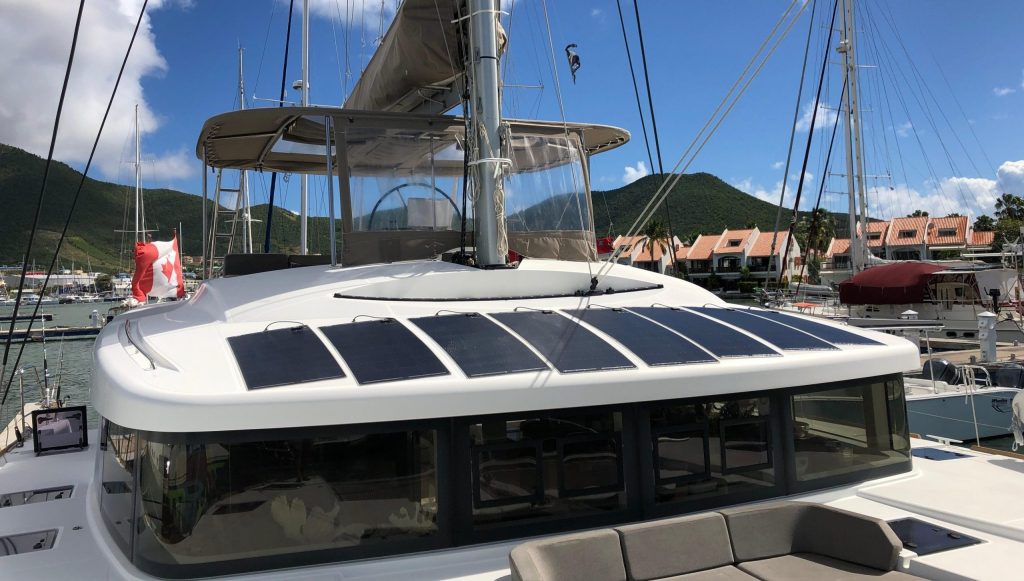
Source: oceanplanetenergy.com
A semi-rigid panel has a strong aluminum backing and an extra thick ETFE laminate non-slippery surface (encapsulating the solar cells).
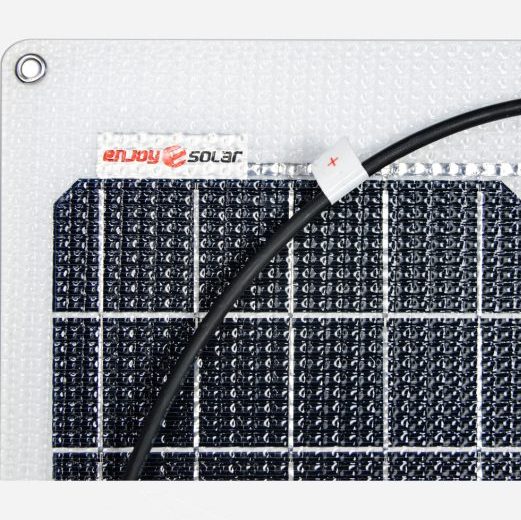
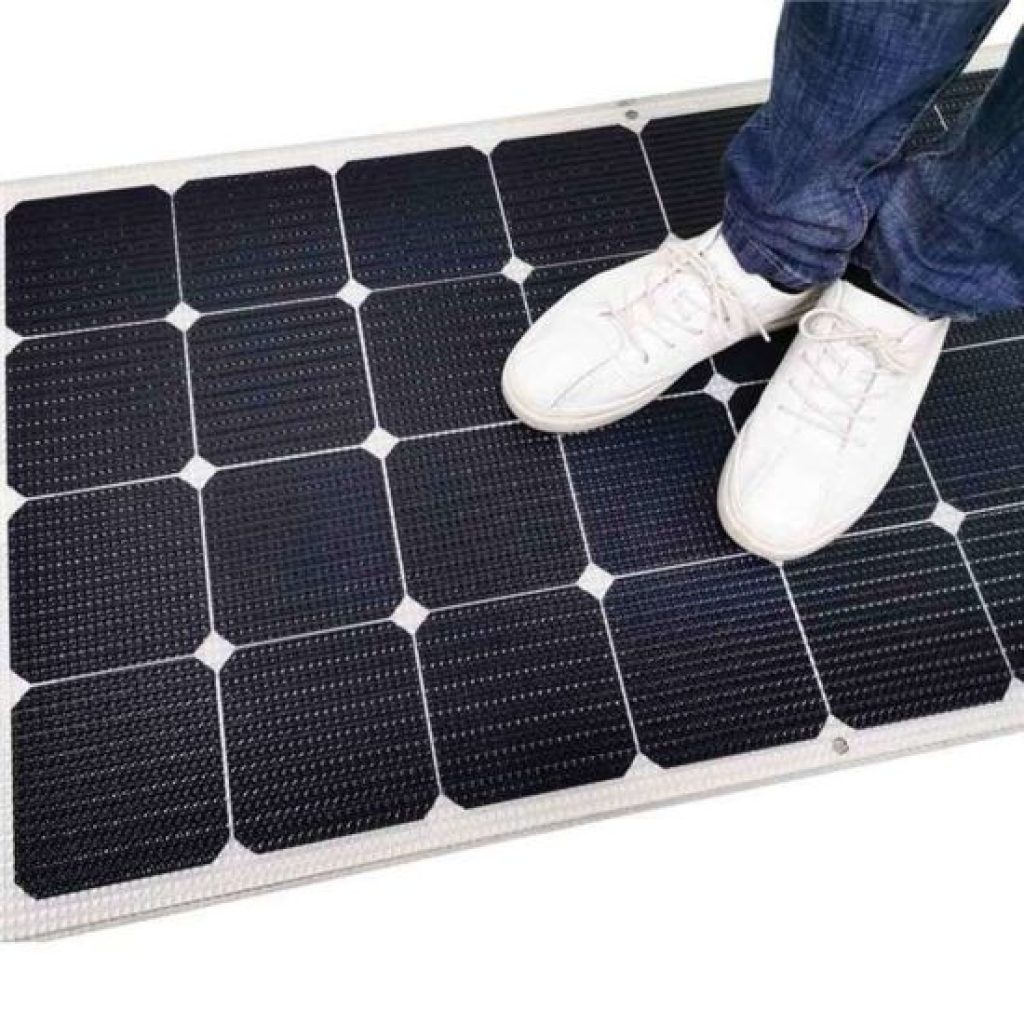
The semi-rigid solar panels are very popular for boats and van roof racks because their installation does not require drilling any holes.
Instead, they can be bonded to a smooth surface using adhesive silicone (like Sika-Flex 252) or even velcro.
To avoid overheating (which decreases performance), the panels need a small air gap to dissipate the heat. You can achieve this by putting a spacer behind the panel, providing just enough space for air to flow between the panel and the surface/roof (you can use double-sided tape, velcro, or plastic cardboard such as Coroplast®).

Source: custommarineproducts.com
In addition, this type of panel is much lighter and thinner than its rigid counterpart while still producing the same amount of power.
However, the lightweight advantage can become a weakness in high winds.
Why? Because without a secure installation, these panels can take off like kites.
For this reason, make sure you’ve selected a quality install option.
Finally, it is essential to point out that this technology is relatively new and expensive, especially since there aren’t that many companies offering this type of product (a good example is Custom Marine Products, which offers several solar panels in the U.S. for boats).
Flexible Solar Panels
Flexible solar panels are designed to contour to curved surfaces and are especially well suited to installation on boats with uneven surfaces.
They’re extremely thin (approximately 2mm) and lightweight, making them easy to transport, install, and store.
So if you need to install a solar panel on a curved surface (with a bending angle of a bit over 30 degrees) or if the surface can’t support a lot of weight, then a flexible solar panel is your best option.
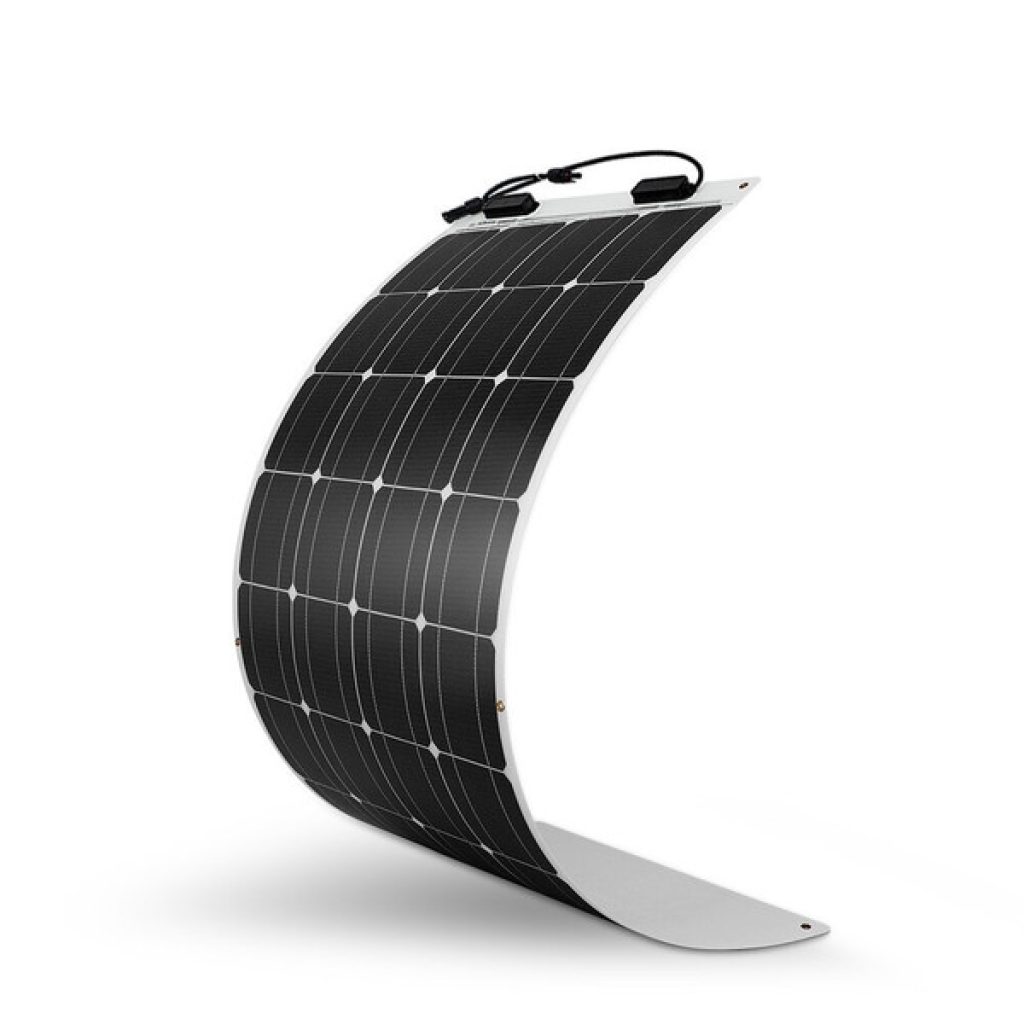
Source: renogy.com
Because flexible panels are very lightweight, you can safely mount them on a bimini top or dodger without fear of collapsing.

Furthermore, flexible panels are waterproof and dissipate heat better than semi-rigid panels.
However, they lack the extra thick ETFE laminate protection (they have an “ultra-thin lamination”), so they’re less robust, and walking on them is not recommended as it might result in internal damage to the solar cells and soldering.
Moreover, their lifespan is much shorter when compared to the lifespan of standard rigid solar panels. Manufacturers usually offer a 5-year warranty for the material.
For these reasons, it’s not surprising that flexible panels are much cheaper than semi-rigid panels.

Below you can find a table in which we compare the weight and thickness of a 100W rigid monocrystalline solar panel and a 100W monocrystalline flexible solar (both from Renogy):
| Specification | Renogy Flexible Solar Panel | Renogy Rigid Mono Solar Panel |
|---|---|---|
| Wattage | 100 W | 100 W |
| Weight | 4 lbs (1.8 kg) | 16.5 lbs (7.5 kg) |
| Thickness | 0.08 inches (2 mm) | 1.2 inches (30 mm) |
| Operating Voltage | 18.9 V | 17.9 V |
| Operating Current | 5.29 A | 5.72 A |
| Production Per Day (U.S. Average) | 400 Wh / day | 400 Wh / day |
| Efficiency | 21.0 % | 21.0 % |
| Average Price | $ 190 | $ 120 |
And if you’re curious to see how much the flexible solar panel from Renogy can be bent, here’s a video for you:
How Much Do Boat Solar Panels Cost?
Boat solar panels can cost anywhere between $150 to $1600 (U.S. dollars).
The following table showing examples of flexible and rigid solar panels and their average prices:
| Manufacturer | Maximum Power Output | Type of Solar Panel | Price (U.S. dollars) |
|---|---|---|---|
| SunPower | 100 W | Flexible, Monocrystalline | $ 200 |
| Renogy | 100 W | Flexible, Mono | $ 160 |
| Top Solar | 100 W | Flexible, Mono | $ 140 |
| Renogy | 175 W | Flexible, Mono | $320 |
| Renogy | 100 W | Rigid, Monocrystalline | $129 |
| BougeRV | 200 W | Rigid, Monocrystalline | $280 |
| Renogy | 200 W | Rigid, Monocrystalline | $270 |
| Newpowa | 240 W | Rigid, Monocrystalline | $280 |
| Renogy | 320 W | Rigid, Monocrystalline | $360 |
| LG | 375 W | Rigid, Monocrystalline | $365 |
| BougeRV | 400 W | Rigid, Monocrystalline | $540 |
| Trina Solar | 400 W | Rigid, Monocrystalline | $330 |
| Panasonic | 400 W | Rigid, Monocrystalline | $505 |
As you can see, flexible panels tend to cost more than rigid panels (comparing panels with the same wattage).
Which Factors Dictate The Cost Of A Solar Panel For Boats
The price of solar panels for boats depends on the panel’s maximum power output, among other factors, such as:
- Manufacturer
- The rigidity of the solar panel (rigid, semi-rigid, semi-flexible)
- Type of panel (monocrystalline, polycrystalline)
- The technology used (standard, PERC, half-cell, etc.)
Let’s discuss these factors a bit further.
Daily Power Output (How Much Power The Panel Generates)
It’s no surprise that, when it comes to a PV module, the more power it can generate (the bigger its wattage), the more it will cost.
But you might be able to use this price difference to your advantage.
For instance, let’s say you’ve calculated that you need to generate 400W with solar panels. In this case, you have a few options:
- Adding one 400W solar panel
- Adding two 200W solar panels
- Or adding four 100W solar panels
Of course, the best option depends on how much space you have on your boat to install your solar panels. But if you have options, try running the math before purchasing.
You might save a few bucks and still generate the same amount of power in the end.
Monocrystalline vs. Polycrystalline
Monocrystalline solar cells are made of a single silicon crystal, so they’re smaller/lighter, more efficient, and can endure higher temperatures.
Conversely, polycrystalline solar cells are made of multiple silicon crystals melted together. Therefore, solar panels made with polycrystalline solar cells are typically larger and less efficient.
Because of its many advantages, monocrystalline panels tend to be more expensive than polycrystalline panels.
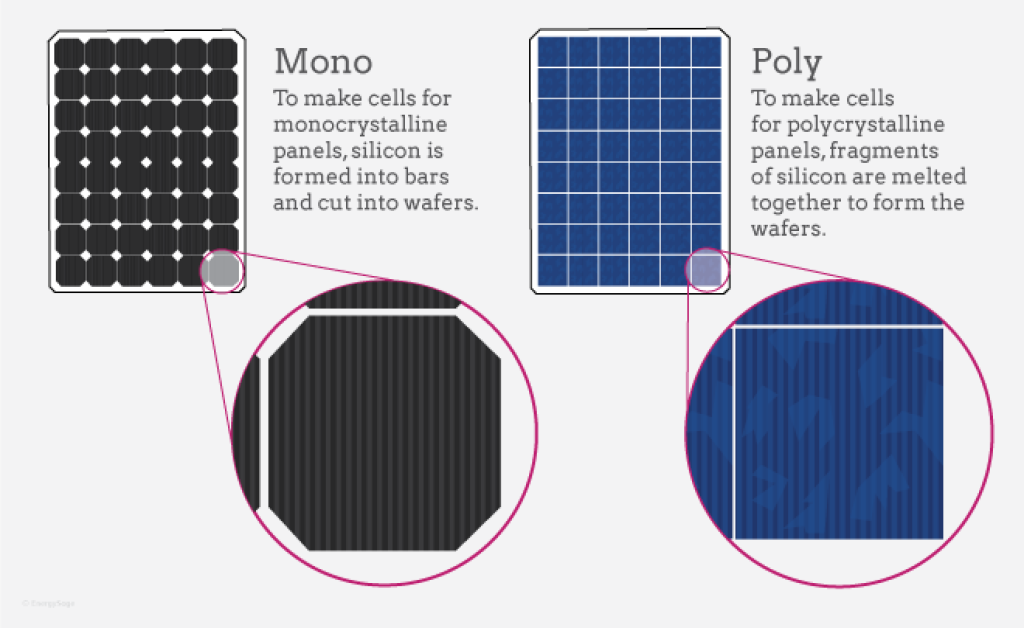
ases.org
Because boats usually don’t have that much room to spare, it is wiser to install the most efficient type of solar panel, the monocrystalline.
It might require more upfront investment, but it takes up less space and generates more energy (when compared to its polycrystalline analog).
Rigid vs. Flexible Solar Panels For Boats
As previously mentioned, there are a few different solar panel options: rigid, semi-rigid, and flexible.
Because their technology has been around for longer, rigid solar panels usually cost less than their semi-rigid and flexible analogs.
Of the three types, the semi-rigid is the most expensive. Still, it’s also the most recommended for boats since it combines the durability and efficiency of a rigid panel with the flexible panel’s ability to bend.
In addition, the market for semi-rigid panels is still very small, and very few companies offer this type of product (examples are: Solara in Europe and Custom Marine Products in the U.S.).
Let’s compare the cost of flexible and rigid panels with the cost of semi-rigid panels:
Cost Of Semi-Flexible Monocrystalline Solar Panels For Boats
| Solar Cell Manufacturer | Power Rating | Amp-hours per day (6h of sun) | Price per panel |
|---|---|---|---|
| SunPower | 55 W | 3.3 Ah | $ 260 |
| SunPower | 70 W | 3.8 Ah | $ 319 |
| SunPower | 115 W | 4.0 Ah | $ 529 |
| SunPower | 120 W | 6.1 Ah | $ 499 |
| SunPower | 130 W | 5.2 Ah | $ 599 |
| SunPower | 145 W | 6.6 Ah | $ 725 |
Cost Of Semi-rigid Monocrystalline Solar Panels For Boats
| Solar Cell Manufacturer | Power Rating | Amp-hours per day (6h of sun) | Price per panel |
|---|---|---|---|
| SunPower | 110 W | 50.8 Ah | $ 659 |
| SunPower | 120 W | 55.4 Ah | $ 719 |
| SunPower | 150 W | 69.2 Ah | $ 899 |
| SunPower | 175 W | 80.8 Ah | $ 1,049 |
Rigid Monocrystalline Solar Panels For Boats
| Solar Cell Manufacturer | Power Rating | Amp-hours per day (6h of sun) | Price per panel |
|---|---|---|---|
| SunPower | 110 W | 50.8 Ah | $ 489 |
| SunPower | 140 W | 65.6 Ah | $ 629 |
| SunPower | 150 W | 69.2 Ah | $ 699 |
| SunPower | 175 W | 80.8 Ah | $ 799 |
| SunPower | 200 W | 92.3 Ah | $ 899 |
| SunPower | 225 W | 103.8 Ah | $ 999 |
Please note: we gathered all the above price information from the Custom Marine Products’ website.
If we compare only panels of the same wattage, we’ll notice that the price increases in the following order: rigid panels < flexible panels < semi-rigid panels.
Final Thoughts
Since boats don’t usually have much room to spare, it is essential to determine how many solar panels you’ll need.
To do that, you must estimate your average daily energy consumption and determine the number of panels needed to meet this demand.
If you don’t have enough space on your boat, consider using more efficient panels that can produce a lot of energy while taking less space.
The best type of panel for boats is the semi-rigid (“walk-on” panels). These panels are relatively new to the solar market and can be pretty expensive.
However, if you don’t have a lot of free space on your boat and your daily energy consumption is relatively high, these panels can be your best option.
We hope this guide has given you the necessary knowledge to determine how many panels you need for your boat and what type of panel is more recommended for boats.
If you still have questions about this topic, feel free to reach out to us; we’ll be happy to help!

